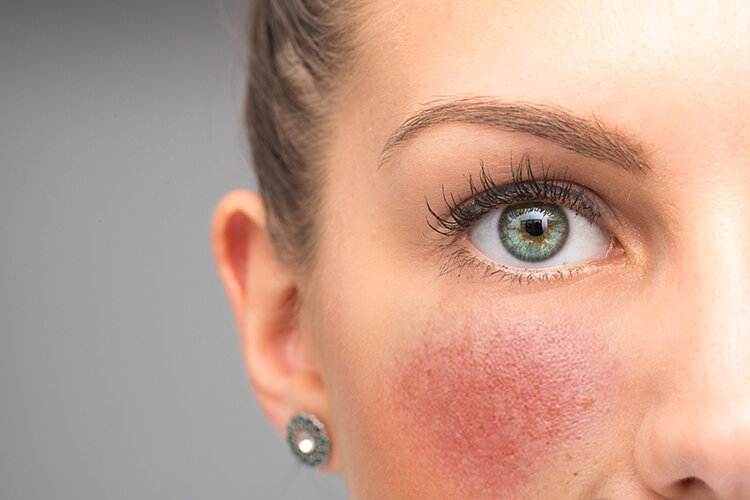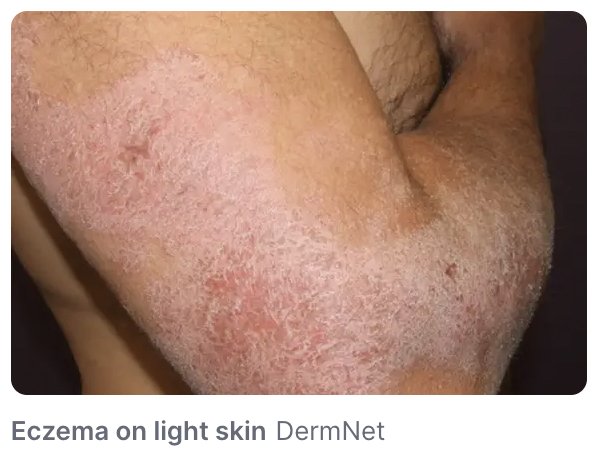Heat Rash vs. Eczema: What's the Difference?
Find out the nuances between these two common skin rashes—and how to prevent and treat them.
By Erin L. Boyle. Medical Reviewer Christopher Sayed, M.D.
When you’re living with eczema, you’re no stranger to an angry red rash. It’s itchy. It’s uncomfortable. So when you start feeling the urgent need to scratch on a hot summer afternoon, it’s natural to wonder: Is this the start of an eczema flare? Or, is it something else, like a heat rash? While eczema and heat rash may look similar, they are very different conditions, each with their own causes.
We went to skin care experts to learn how to tell the difference between eczema and heat rash—and what you can do about easing the symptoms of both.
What Is Heat Rash?
A heat rash is a skin condition that’s also known as miliaria or prickly heat, says Ariel Ostad, M.D., a triple-board certified dermatologist and a clinical associate professor in the Ronald O. Perelman Department of Dermatology at NYU Grossman School of Medicine in New York City. Heat rash happens for a very specific reason, he says. “[It’s] caused by blocked sweat ducts and trapped sweat beneath the skin, which are common during hot, humid weather,” Dr. Ostad explains.
Once your ducts and pores become blocked, the trapped sweat can trigger a localized immune response, leading to a raised rash with a stinging, burning, or itching sensation. But this also means that when they’re unblocked with treatment, the rash will often stop (more on treatment later).
Heat rashes are most common in babies and children, because their sweat glands and ducts are smaller and can become blocked more easily, says Gibran Shaikh, M.D., a board-certified dermatologist and founder of MySkinofColor.com, the first teledermatology platform designed for people of color. He's also a clinical instructor in the department of dermatology at Mt. Sinai in New York City. In fact, an estimated 4% to 9% of newborns between one and three weeks of age will get a heat rash, according to the Cleveland Clinic.
But adults can have heat rashes, too, Dr. Shaikh points out, especially after physical exertion or exercise. And for those who live in hot and humid climates, heat rashes can be a real problem—affecting nearly 30% of adults in those areas. Fever (typically defined as a body temperature of 100.4 degrees Fahrenheit or higher) can be another cause of heat rashes.
There are different types of heat rash, according to the Mayo Clinic. They’re classified by the depth of obstruction of the sweat duct, causing clinical and physical differences—so they’re all essentially the same rash, just with different severity levels, reports authors of a 2022 National Library of Medicine book on the topic.
Miliaria crystallina is the mildest form of heat rash, and basically goes skin-deep.
Miliaria rubra is the most common type of heat rash that goes deeper into the skin.
Miliaria pustulosa occurs when a heat rash becomes infected and fills with pus.
Miliaria profunda is when the rash goes deepest into the skin—and is also the least common type.
While they vary in size, common locations for heat rashes are on the back, underarms, arms and legs, under the breasts, and neck, says Christopher G. Bunick, M.D., a board-certified dermatologist and an associate professor of dermatology, specializing in general medical dermatology and dermatologic surgery, at Yale School of Medicine in New Haven, CT. It often happens in places on the body with creases or folds where heat and sweat get trapped.
What Is Eczema?
Unlike heat rash, which is one rash with different levels of severity, eczema is a kind of umbrella term for a group of skin conditions that cause itchy, dry skin. Eczema is incredibly common, happening to some 31 million Americans, about 9.6 million of whom are children under the age of 18, according to the National Eczema Association.
The reasons behind eczema are different from heat rash, too: “Eczema is a chronic, immune-mediated condition that usually starts in childhood,” Dr. Shaikh explains. “It’s thought to be due to a … compromised skin barrier.” Some people naturally have skin that loses water to the environment more easily, says Dr. Shaikh, resulting in a dry, damaged barrier that allows the penetration of allergens, which then elicits an immune response. “And that immune response is itchy,” he adds. “That leads to rubbing and scratching, which further compromises the barrier, and then that leads to this itch-scratch-itch cycle.”
Eczema even has a catch-phrase that explains all of this in a few words: It’s the “itch that rashes,” he says. And unlike a heat rash, which ceases if you can stop the source of sweat blockage, eczema is a chronic condition which can “flare”—or cause symptoms—and then not cause issues until another flare.
Seven distinct types of eczema exist, according to the National Eczema Association. Some types commonly start in children (about one in 10 children have eczema) and continue into adulthood, but can start in adulthood too.
The most common type, atopic dermatitis, can be triggered by many things, including exposure to allergens (such as peanuts, pet dander, and pollen), stress, dry skin, infection, weather, and skin irritants (like some fabrics and soaps). It’s interconnected with other common allergic conditions, too. “Atopic dermatitis runs in families that have the atopic triad—asthma, eczema, or allergic rhinitis (seasonal allergies),” Dr. Bunick points out—but heat rash is not a part of that triad.
In addition to atopic dermatitis, other types of eczema include:
Contact dermatitis, which is triggered by environmental factors.
Seborrheic dermatitis, which is likely triggered by an overgrowth of Malassezia yeast, a substance normally found on the skin. But in these cases, it can lead to inflammation on the scalp and face.
Nummular eczema’s exact triggers aren’t known, but it might be caused by things like allergies, bacterial infections, and drying soaps.
Dyshidrotic eczema causes small, itchy blisters on hands and feet.
Stasis dermatitis is eczema that typically occurs on the lower legs of people with poor circulation.
Hand eczema is eczema that only shows up on hands. It’s often associated with exposure to chemicals (cleaners, hair products, etc.) that irritate skin.
For adults, teens, and children, eczema commonly happens on the back of body parts—like the back of knees, back of the neck, back of the elbows. It can also happen on the hands and palms of the feet. It’s rare on the face in these age groups. But in babies, it’s most common on the face, including the cheeks. It also happens on the outer surfaces of the arms and legs, the back, stomach, and chest for babies.
What Do Heat Rash and Eczema Look Like?
Wondering what these skin conditions look like on various skin tones? Different, but similar in some ways, it turns out.
For heat rash, the affected area often looks like groups of small bumps on the skin. They can resemble pimples or blisters, our experts say. “For lighter skin tones, it may appear to be red,” Dr. Ostad explains. For skin of color, how heat rash appears might actually be similar to how eczema appears, Dr. Shaikh says—that red skin tone is not as obvious, or it may be kind of purple in color. “It’s often quite subtle,” he says. The clinical symptoms of a burning, itchy sensation associated with a heat rash, plus the bumps on the skin that can come with it, can be helpful in making a diagnosis of heat rash in skin of color.
For eczema, the shape and size of the rashes can differ by type, but the common denominator is itchy, dry patches of skin that may appear red for people with white skin. That redness can be subtle in eczema in skin of color, just like with heat rash, Dr. Shaikh says. It could be purple, darker brown, or ashen grey. That difference is important, because research has found that more Black children have atopic dermatitis than white children and Asian children—19.3% compared to 16.1% and 7.8%, respectively—so correct diagnosis is important.
Dermatologists will often use other indicators to determine if a patient of color has eczema, like secondary changes from the eczema itself, Dr. Shaikh says. Those can include scratching from itching, dryness, swelling, or oozing.
So, overall, how do you tell the difference between the two?
“Most eczema rashes are pink and scaly [in white skin], while the heat rash is pink and bumpy without scale,” explains Elizabeth A. Mullans, M.D., a board-certified dermatologist at Uptown Dermatology in Houston, TX. And in skin of color, both skin issues might be more purple or have other subtle differences that your doctor will note.
Of course, a dermatologist, who specializes in skin conditions, should have the final say on whether you have a heat rash or eczema… because diagnosis matters, especially when it comes to the treatment of each condition.
How to Treat Heat Rash and Eczema
Just like the treatment for cold and flu are often slightly different, so are treatments for heat rash and eczema.
Heat rash usually resolves on its own, especially if you move into a cool, dry environment, Dr. Mullans says. “Topical steroid creams or anti-itch creams can be used if the heat rash is uncomfortable,” she says.
In contrast, while eczema can resolve in some people, in the majority, it’s a life-long chronic condition marked by flares, our experts say. Those cases can—and should—be treated, especially to prevent infections and other issues. Eczema may be treated topically (with moisturizers and corticosteroids) or systemically (with immunomodulators and biologics). Dr. Mullans say.
Can You Prevent Eczema and Heat Rash?
What about preventing these skin issues? “Eczema [flares] can sometimes be prevented, depending on the type of eczema,” she says. If you have sensitive skin that can flare with eczema, be sure to moisturize daily and use fragrance-free products, avoid piping hot showers, and don’t forget things like sensitive laundry detergent and household cleaning products.
“Heat rash can be prevented by avoiding activities that result in sweating and avoiding hot, humid environments,” Dr. Mullans says. Other ways to stop heat rash include wearing cotton clothing that allows better airflow, skipping tight and restrictive clothing, and making sure your skin is cool, the Cleveland Clinic reports.
Bottom Line
Eczema and heat rash look (and feel) very similar, but it’s important to understand their differences so that you get effective treatment. Eczema is chronic and influenced by genetic and environmental factors, while heat rash is often the result of blocked sweat ducts from excessive seating and exposure to heat. If a new skin irritation still has you stumped don’t hesitate to consult with a dermatologist to determine if it’s a heat rash or an eczema flare.
Notes: This article was originally published May 30, 2023 and most recently updated June 2, 2023.





